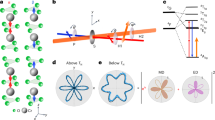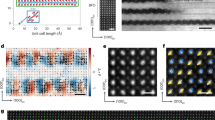Abstract
Kurtz and Robinson1 have recently proposed a physical model of the electro-optic effect. On its basis they have derived expressions for the electro-optic coefficients of centrosymmetric and non-centrosymmetric crystals. They have also established a relationship between the linear and the quadratic electro-optic coefficients in ferroelectric materials in terms of spontaneous polarization. According to this model the linear electro-optic coefficient vanishes for centrosymmetric crystals. This conforms with the general concept. The purpose of this communication is to point out that a small linear electro-optic effect is also expected to occur in centrosymmetric crystals. Kurtz and Robinson's model1 is modified with respect to this point and a rough theoretical estimate for linear electro-optic coefficients of such crystals is obtained.
This is a preview of subscription content, access via your institution
Access options
Subscribe to this journal
Receive 51 print issues and online access
$199.00 per year
only $3.90 per issue
Buy this article
- Purchase on SpringerLink
- Instant access to full article PDF
Prices may be subject to local taxes which are calculated during checkout
Similar content being viewed by others
References
Kurtz, S. K., and Robinson, F. N. H., Appl. Phys. Lett., 10, 62 (1967).
Adler, E., Phys. Rev., 134, A, 728 (1964).
Terhune, R. W., Maker, P. D., and Savage, C. M., Phys. Rev. Lett., 8, 404 (1962).
Author information
Authors and Affiliations
Rights and permissions
About this article
Cite this article
BALI, L. Linear Electro-optic Effect and Centrosymmetric Crystals. Nature 220, 472–473 (1968). https://doi.org/10.1038/220472a0
Received:
Issue date:
DOI: https://doi.org/10.1038/220472a0



